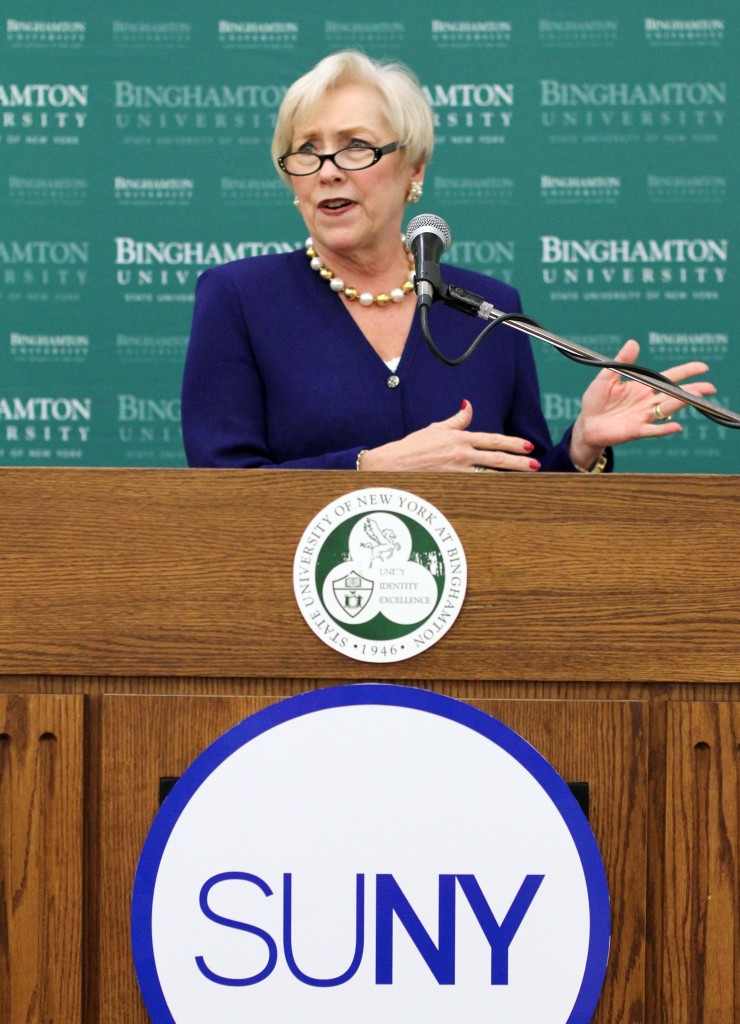
SUNY schools from across the Southern Tier exhibited their favorite programs at the Southern Tier SUNY Showcase on Wednesday in the Mandela Room in the Old University Union.
Kaitlin Gambrill, assistant vice chancellor for strategic planning for SUNY and an organizer of the showcase, said the Southern Tier Showcase was the eighth of 10 showcases planned by SUNY Chancellor Nancy Zimpher. It was designed for campuses to highlight their programs as part of the chancellor’s “The Power of SUNY” plan to revitalize New York state’s economy.
Zimpher said the SUNY showcases serve as an opportunity to demonstrate that SUNY can be an economic driver for the state.
“We are going to all 10 regions of the state and our principal message is, ‘look what SUNY is doing for New York,’” Zimpher said.
The Southern Tier is a particularly interesting region, Zimpher said, because the composite of the campuses represented at the showcase service 44,000 students in total, employ more than 9,000 faculty and staff, and have produced almost 100,000 alumni — many of whom have stayed to live and work in the Southern Tier.
“And does that make a difference to the Southern Tier?” Zimpher asked. “You bet it does.”
Binghamton University President Harvey Stenger spoke briefly about the developing programs at BU. Presidents of Broome and Corning Community Colleges, as well as the provosts from SUNY Delhi and Cornell University, followed.
Stenger and BCC President Kevin Drumm signed a memorandum of intent to continue to develop Binghamton Advantage, a joint admissions program between the two schools.
Stenger said Binghamton Advantage began in fall 2011 and offers certain students who were not initially accepted into BU the opportunity to live on campus while taking courses at Broome Community College. After one or two years at BCC, students in the program will be offered automatic acceptance to BU.
“I think it is a great service that we are providing to the community,” Stenger said.
Health care and energy were the two other areas represented at the Southern Tier showcase that, according to Gambrill, distinguished it from the others.
Representatives from the Decker School of Nursing brought two high-tech simulators that students practice with to show how Decker is using new technology to increase student competency, said Patti Reuther, a clinical instructor in Decker.
Reuther said she agreed that health care is a primary concern of the Southern Tier campuses, especially because a pending legislation in New York requires all nurses in the state to have a Bachelor of Science. This would make Decker the hotspot of nursing education in New York.
“Binghamton University is the No. 1 producer of B.S. prepared [registered nurses] in the state,” Reuther said. “If the legislation passes, we’re it. We’re one of the major players.”
Prior to this speech, Stenger also announced that the Public Archeology Facility, a research center in the anthropology department, received notice of a pending five-year contract for $20 million from the Department of Education for cultural resource investigations by the Department of Transportation.
Nina Versaggi, director of the Public Archeology Facility, said the Department of Education already notified BU that they had been awarded the contract, and it only needs to be signed before it becomes official.
In addition to the contract, Stenger said the Facility was unveiling an exhibit that uses touch-screen computers to make PowerPoints featuring the findings of their recent excavations in Downtown Binghamton.
In the future, Versaggi said the facility plans on bringing the computers to various community venues.
“People will have the opportunity to select the type of project they want to learn about, and just press a button and the PowerPoint comes up,” she said.
Along with Decker, the Center for Civic Engagement, the Confucius Center, the Public Archeology Facility and the Small Scale Systems Integration and Packaging Center all had stations to show their contributions to BU. Students from the Watson School of Engineering also attended.
Bryan Balch, a senior majoring in mechanical engineering, helped represent the Watson School at the showcase. He talked with Chancellor Zimpher about a car he and nine other Watson students designed to enter in a competition in Alabama next month.
“We wanted to show her how we applied our engineering education so we can build a reliable, safe car,” Balch said.
University spokeswoman Gail Glover wrote in an email to Pipe Dream that she thought the showcase was a huge success.
“Binghamton University had a number of showcase units, which allowed us to demonstrate the broad range of technical achievement, international access and community service we achieve,” Glover said.
She added that the showcase also served as an opportunity to see the top programs of the other regional schools.
“It was really interesting to see what each of the campuses had to offer,” she said.


